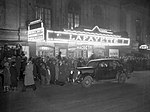133rd Street (Manhattan)

133rd Street is a street in Manhattan and the Bronx, New York City. In Harlem, Manhattan, it begins at Riverside Drive on its western side and crosses Broadway, Amsterdam Avenue, and ends at Convent Avenue, before resuming on the eastern side, crossing Seventh Avenue, and ending at Lenox Avenue. In Port Morris in the Bronx, it runs from Bruckner Boulevard/St. Ann's Place to Locust Avenue. The block between Seventh Avenue and Lenox Avenues was once a thriving night spot, known as "Swing Street", with numerous cabarets, jazz clubs, and speakeasies. The street is described in modern times as "a quiet stretch of brownstones and tenement-style apartment houses, the kind of block that typifies this section of central Harlem".
Excerpt from the Wikipedia article 133rd Street (Manhattan) (License: CC BY-SA 3.0, Authors, Images).133rd Street (Manhattan)
Adam Clayton Powell Jr. Boulevard, New York Manhattan
Geographical coordinates (GPS) Address Nearby Places Show on map
Geographical coordinates (GPS)
| Latitude | Longitude |
|---|---|
| N 40.813888888889 ° | E -73.944722222222 ° |
Address
Adam Clayton Powell Jr. Boulevard 2257
10027 New York, Manhattan
New York, United States
Open on Google Maps








